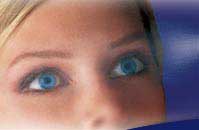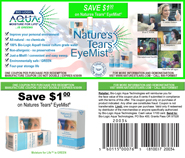
Dry Eye
Dry Eye Treatment
Here is what eye doctors can do.In addition to the specific dry eye therapies listed below, treatment for dry eye could include treatment for underlying physical conditions; and counseling regarding lifestyle, medication, self-medication, eye protection, diet and nutrition, and high risk environments.
The suggestions described in the "Prevention" section should also be part of any treatment. In cases of mild or transient dry eye, prevention measures alone may often take care of the problem.
Current dry eye medical treatment armamentarium:
- Artificial tears. These over-the-counter applications are the most common dry eye remedy.
- Placed in the eyes as drops and typically contain chemicals that attempt to mimic the natural tear film's water, saline and lipid components.
- Because many individuals are allergic to preservatives, artificial tears are available as either "preserved" (in bottle) or "unpreserved" (in single dose vials).
- Designed to reduce tear film osmolarity (water attracting ability) to more normal levels (this can also be accomplished with a pH balanced water mist).
- Most beneficial for individuals whose dry eye is accompanied by impaired lipid production.
- Large-bolus drops may flood and wash away the existing natural tear film, including lipids (increasing the risk of tear evaporation), antibodies, growth factors and beneficial proteins. Eye drops also thin the mucin layer.
- Artificial tears contain no enzymes, growth factors or antibodies.
- Many people find artificial tears uncomfortable to apply.
- Tear stimulants. This is a class of prescription oral medications that stimulate tear production in the lachrymal glands. They also increase saliva production, which would benefit an individual who also had dry mouth but may cause discomfort in someone who does not.
- Personal tear film humidifier. This over-the-counter application is a new discovery that increases only the water content of the tear film's aqueous layer.
- Applied as a fine water mist using a personal, portable hand-held humidifying device.
- Temporarily increases the humidity of the air in front of the eyes. The tear film then naturally absorbs this increased moisture.
- The mist is pH correct for tear film application, with a mineral solute content that is non-dehydrating
- When water evaporates from the tear film, discomfort may be caused by the resulting over-concentration of the remaining components, especially salt. Dilute the aqueous layer with an ultra-fine, easily tolerated water mist and normal tear film functioning is often restored.
- Water mist does not flood or wash away the existing lipid layer or non-water aqueous layer components.
- Punctal plugs. This medical procedure involves the placement of small silica plugs in the "puncta" of the lower eyelids. Puncta are drains that allow excess tear to flow out of the eye area.
- In severe dry eye, blocking the puncta can increase the volume of tears retained in the "tear lake" covering the eye and lower eyelid. It is often not necessary to block every punctum.
- "Punctal occlusion," or permanent blocking of the puncta through cauterization, is a more drastic and permanent option.
- Anti-inflammatory medication. Dry eye is considered a "disease of inflammation" and anti-inflammatory medications work by disrupting the hormonal signals to the brain that cause the inflammatory response.
- Anti-inflammatory medications for dry eye are sold by prescription, usually as eye drops.
- The most common category of anti-inflammatory drug is the "cyclosporins." These immuno-suppressants are also used to prevent rejection after organ transplants, and to treat inflammatory autoimmune diseases such as psoriasis.
- Caution: Some anti-inflammatory medications for dry eye claim in their advertising to "increase tear production," making them sound like tear stimulants, which they are not.
- Anti-inflammatory steroids may also be used to treat dry eye but they tend to have numerous adverse side effects and should be carefully monitored.
- Hormonal medication. Hormone therapy falls largely in the category of "treating an underlying cause," such as menopause. The approach has not been proven effective specifically for dry eye treatment and may be accompanied by numerous adverse side-effects.
Caution: Be careful when using eye droppers. Avoid touching the part the goes into your eye with your fingers and avoid touching the dropper to your eyes, eyelids or eye corners. Failure to follow these precautions may result in eye infection or injury. Consider running the dropper tip under hot water or cleansing it with alcohol after each use. A contaminated dropper may also contaminate the contents of the accompanying container.
Related articles and sources- Dry Eye and Moisture Supplementation (Sharon Kleyne Hour, 407-08, Philip Paden, MD)
- Dry eye Remedy (Sharon Kleyne Hour, 7-30-07, Robert Latkany, MD)
- Eye Care, Eyewear and Children's Vision (Sharon Kleyne Hour, 3-19-07, Marge Wingler)
- How to Use Eye Drops Safely (5-25-11, Bio-Logic Aqua Research)
- Living with Chronic Dry Eye (Sharon Kleyne Hour, 4-11-11, Rebecca Petris)









